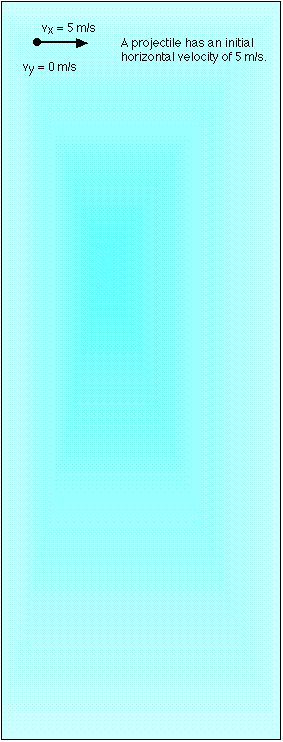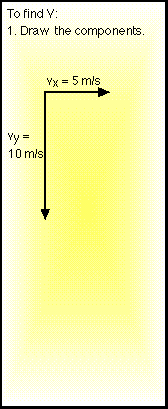Velocity of a Projectile
![[Prev]](../../NavIcons/Prev.GIF)

![[Index]](../../NavIcons/Up.GIF)
![[Home]](../../NavIcons/Home.GIF)
![[Help]](../../NavIcons/Help.GIF) [non-animated version of this
page]
[non-animated version of this
page]
BHS
-> Staff
-> Mr. Stanbrough ->
Physics -> Mechanics
-> Projectiles -> this page
|
The Velocity of a Projectile
|
|

|
The Components of the Velocity
We know that the vertical motion of a projectile is the same as
its motion would be in free fall. Therefore, the vertical component
of its velocity changes by 10 m/s (actually 9.8 m/s) each second.
We also know that the horizontal motion of a projectile is at
constant velocity - if it starts at 5 m/s (for instance), the
horizontal component of its velocity remains 5 m/s until it hits the
ground.
Finding the Velocity from its Components
 If
you know the horizontal and vertical velocity components, you can
find the magnitude of the projectile's velocity and the projectile's
direction of motion as follows:
If
you know the horizontal and vertical velocity components, you can
find the magnitude of the projectile's velocity and the projectile's
direction of motion as follows:
- Draw the horizontal and vertical velocity components (to
scale) starting from a common point.
- Draw 2 more sides to complete a rectangle.
- The velocity of the projectile is the diagonal of the
rectangle that starts at the point from which you drew the
velocity components.
- You can determine the magnitude of the velocity by measuring
the scale drawing or using the Pythagorean Theorem.
- You can determine the angle that the velocity makes with the
horizontal (or vertical) by measuring the scale drawing with a
protractor, or using trigonometry.
![[Prev]](../../NavIcons/Prev.GIF)

![[Index]](../../NavIcons/Up.GIF)
![[Home]](../../NavIcons/Home.GIF)
![[Help]](../../NavIcons/Help.GIF) [non-animated version of this
page]
BHS
-> Staff
-> Mr. Stanbrough ->
Physics -> Mechanics
-> Projectiles -> this page
[non-animated version of this
page]
BHS
-> Staff
-> Mr. Stanbrough ->
Physics -> Mechanics
-> Projectiles -> this page
last update September 18, 2000 by JL
Stanbrough
If
you know the horizontal and vertical velocity components, you can
find the magnitude of the projectile's velocity and the projectile's
direction of motion as follows: